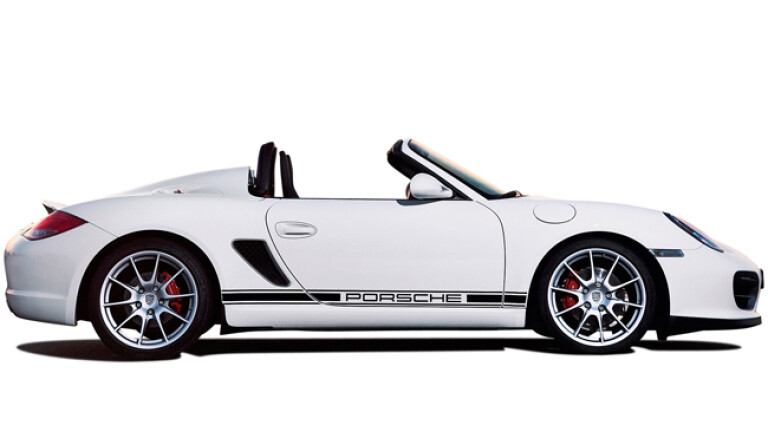
ICONS never die at Porsche, they just develop carburettor trouble. For example, media types attending the Boxster Spyder launch near Monterey, California were offered rides in an original Porsche 550 Spyder – shortly before it broke down.
Thankfully, the new Boxster Spyder is no 550.
For one thing, it’s 750kg heavier, though at 1275kg it is 80kg lighter than a regular Boxster S and the lightest street-legal car Porsche currently builds. Think of it as being squeezed out of the same Cheez Whiz can as the lightweight GT3 RS. You pay more for less of everything except performance. It’s a marketing cow Porsche has milked many times, usually to enthralling effect.
The metamorphosis from $140,400 Boxster S to $152,000 (estimated) Boxster Spyder happens like this: the power top is gutted, replaced by a canvas handkerchief that looks like it came off the Victoria Secret XXL rack.
It hooks to the windscreen header and snaps to the roll hoops. Where the S has a steel boot lid and top cover, the Spyder has a single, spectacular 9.8kg bonded and blind-riveted aluminium panel with double-hump fairings reminiscent of those on the Carrera GT. Two long fingers of the top reach to exposed hooks in the panel – the only blemishes on an otherwise perfect bod – which serve as the top’s rearmost anchors.
The top serves as a bimini-style sun shade or can be weather sealed with a separate snap-in panel that contains a plastic rear window. Or it rolls up and stores underneath the aluminium hatch. It looks hopelessly complicated the first 23 times a Porsche tech demonstrates it, but after a few tries you’ll soon match the pro’s one-and-a-half-minute roof-raising time.
Elsewhere, an extended chin splitter and a large fixed rump spoiler identify the Spyder and help slash aerodynamic lift by a claimed 60 percent. Black striping and titanium-hued grille accents are among the eye candy. The Spyder drops 20mm on dedicated 19-inch forged aluminium rims and the suspension is retuned with shorter springs up front, stiffer springs in the back, and firmer shock absorber calibrations.
An extra 8kW and 10Nm from the 3.4-litre flat-six and you have potential to hit 100km/h from rest in around 4.5sec (possibly faster with optional PDK). Organic steering and the brassy wail of a flat six are Boxster earmarks, but any suspension elasticity has been starched right out of the Spyder. It comically jiggles your softer parts as it shudders down city streets.
The Spyder craves a track or, short of that, a spaghetti course of switchbacks to devour. The grip creates a g-force pile-on, and oh, the stability. A mid-engine Spyder stays glued and neutral, with none of the bounding and spooky steering wash-out that haunts all the rear-engine 911s. Bridgestone Potenza RE050A tyres aren’t the flashiest rubber in the catalogue, but they reveal no shortcomings fitted to this machine. This is the best handling stock Porsche, period.
Power windows and door locks remain, but the doors are rendered in aluminium rather than steel and the bare door panels have a rudimentary pull strap a la GT3 RS. The seats are stiff, minimally padded carbonfibre buckets with manual sliders. The Spyder comes without air conditioning, stereo, or sat-nav, and with a smaller battery – but not in Australia, where the normal equipment will be fitted.
People want what they can’t have, and with just 30-40 Spyders headed to Australia in 2010, expect the queue to be long and rowdy.

COMMENTS